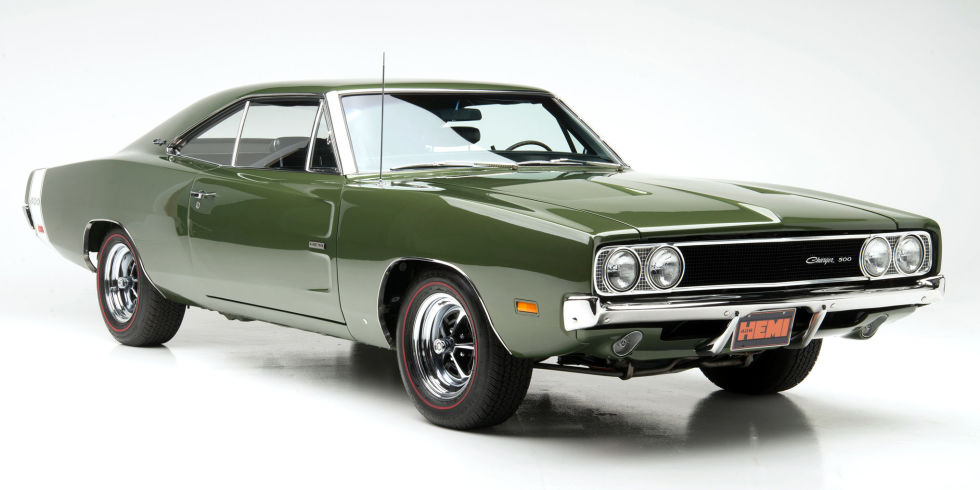The Unknown Muscle Car Dodge Built to Dominate NASCAR!
The Dodge Charger 500 came before the Charger Daytona. It was supposed to dominate NASCAR. It didn't.
Many
people are aware of the "Aero Wars" of 1969 and 1970 in NASCAR, when
Chrysler and Ford reshaped their cars in radical ways to make them go
faster. While pushing the bounds of what could plausibly be called
"stock" cars, the companies raced—and sold to the public—some of the
most outlandish cars ever built in Detroit. And one of the lesser known
cars–the Charger 500–is also the rarest of the bunch.
By
the mid-1960s, the automakers realized that sheer horsepower was not
enough to win on the big tracks of NASCAR. Sure, they could push a car
into the 180+ mph range, but at those speeds the cars often became
unstable. And there was the problem of diminishing returns. The faster a
car is pushed into the air, the more horsepower it needs to get more
speed. Chrysler brought in rocket scientists to study the problem and
they pointed to the obvious answer: streamlining.
In
1968, Dodge had released a new body style for the Charger. It won
awards, sold well, and raced horribly. The car had an indented grille
and the rear window was also recessed. In a wind tunnel the car was a
catastrophe. Too much air got under the car and the air that went over
swirled over the trunk. Someone suggested making the grille flush with
the leading edge of the hood and filling in the cavity at the rear. Wind
tunnel tests confirmed that this would solve many of the car's
problems.
At the time,
NASCAR required at least 500 cars to be sold to the public for a car to
be considered "stock." When the tests confirmed improvement with the
modifications, Dodge gave the go-ahead for the cars to be sold to
consumers. Dubbed the "Charger 500," The car was unveiled to the press
in June 1968 and then pitched to the NASCAR czar, Bill France. France
had no problem with the car being allowed to race except he objected to a
spoiler Dodge wanted to place under the car's front bumper.
NASCAR was hesitant about any aerodynamic modifications on the cars.
NASCAR
was hesitant about any aerodynamic modifications on the cars which made
them look more like race cars and less like street cars (The opposite
of today). France met with Chrysler engineers to discuss the Charger 500
and told them his only objection was the front spoiler. John Pointer,
an outspoken Chrysler aerodynamicist, noted to France that the car he
had driven to the meeting–an Indianapolis "Pace Car" Camaro–had a front
spoiler on it. Apparently unware of the fact, France got on his hands
and knees in the parking lot to inspect the car's front spoiler.
The
memo went out July 18, 1968 to Dodge dealers, telling them the 1969
Dodge Charger 500 would be available in very limited numbers. Initially,
dealers were told the car would only be available with the 426 Hemi.
Dodge shipped unfinished 1969 Chargers to Creative Industries and let
them install the grille, front spoiler, rear window plug, and chrome
a-pillar covers which the engineers had also found helpful in the wind
tunnel. Dodge also decided to make the car available with a 440. Base
price was $3,843 and a Hemi would bump that up by $648. Most experts
think the cars were sold at a loss.
But
somewhere along the line, Dodge either lost interest in building the
street cars or someone noticed that France wasn't counting how many cars
were actually being built. Most agree that only 392 Charger 500s were
built and sold to the public. And for those who are curious, none of
those were ever raced. The cars NASCAR drivers and others raced were
simply the ones they had been racing when the modifications were
announced. Chrysler sent the parts necessary to turn a regular Charger
into a 500 to the teams racing the Chargers and they simply upgraded
their rides.
Everyone
knows the rest of the story: The Charger 500 did not dominate or
compete at the level Chrysler had hoped. They pulled out all the stops
in their next effort when they built and sold the Dodge Charger Daytona
with its nosecone and huge wing. That one was sold in appropriate
numbers for NASCAR homologation, with 503 turned loose on the streets.
And while those are highly sought after in the collector market, many
people have forgotten that the interim Charger 500 is actually a rarer
car. And the prices of the 500s are climbing. They will probably never
reach the values of their winged brethren but a nicely maintained
example sold at auction in 2014 for $181,500. Not bad for a car which retailed for $5,821.91.
Steve Lehto is a writer and attorney
from Michigan. He specializes in Lemon Law and frequently writes about
cars and the law. His most recent books include Preston Tucker and His
Battle to Build the Car of Tomorrow, and Dodge Daytona and Plymouth
Superbird: Design, Development, Production and Competition. He also has a
podcast where he talks about these things.

